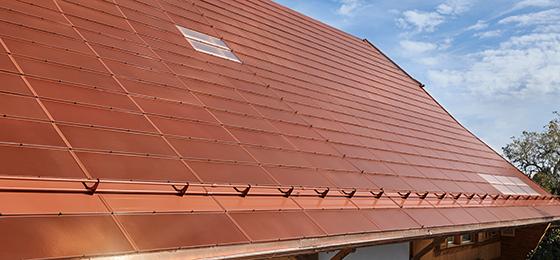Building-integrated photovoltaics: aesthetic, efficient and widely accepted

Within the scope of National Research Programme “Energy Turnaround” (NRP 70), researchers studied photovoltaic systems integrated into the roofs and façades (BIPV) of existing buildings from the point of view of aesthetic, ecological and economic criteria. Their findings: all developers and architects could use this technology for the renovation of existing buildings.
Photovoltaic systems installed on roofs and façades could produce more than 50% of the present-day electricity demand. To accomplish this, however, use would also have to be made of existing buildings, especially residential dwellings in towns and cities. But some property owners and architects continue to doubt whether the integration of photovoltaic systems into buildings is economically viable and meets the aesthetic requirements of the surroundings.
These doubts are unfounded, however, as researchers at EPF Lausanne, the University of St Gallen, the Lucerne University of Applied Sciences and Arts and the School of Engineering and Architecture of Fribourg were able to demonstrate on the basis of a variety of case studies and a survey among property developers.
Photovoltaic modules as a new and versatile building material
“Thanks to new production processes, building-integrated photovoltaic systems have evolved into an innovative and attractive building material in both urban and rural areas. The enormous variety of colours, textures and formats that are now available means that photovoltaic modules can be flexibly integrated into roofs and façades. This applies to all types of buildings as well as to renovation projects, ranging from farmhouses to high rises and from minor maintenance measures through to complete renovation,” explains Emmanuel Rey, head of the Laboratory of Architecture and Sustainable Technologies (LAST) at EPF Lausanne.
Economically viable as well as ecological
Although the initial investment in a renovation project with BIPV is higher than the cost of renovation without a PV system, this solution nonetheless yields significant benefits in terms of economic viability as well as energy efficiency. Investors can anticipate a satisfactory return, especially if building-integrated photovoltaics is considered early in the planning stage and is then optimised in accordance with various criteria. The amortisation period for both non-renewable primary energy and greenhouse gas emissions is significantly shorter than the anticipated service life of a building-integrated photovoltaic system.
Depending on the type of building, the installation method and the utilised energy storage system, it is possible for a renovated building with BIPV to achieve a self-sufficiency rate of up to 87%, if at the same time the fossil-fuelled heating system is replaced by, for example, a heat pump.
Broad variety of options for owners and architects
PV modules integrated into roofs and façades are now more widely accepted than conventional roof-mounted systems, which is a significant factor in urban regeneration processes. A survey among house owners revealed a clear preference for modules that fit in with the architecture, are available in a choice of colours (particularly black and red) and wherever possible are produced in Switzerland or elsewhere in Europe. Thus the majority of them are prepared to pay more for BIPV systems than for non-integrated solutions.
“With these new technologies for integrating photovoltaic systems into buildings, developers and architects now have a broad range of options for combining architectonic quality with the necessity to generate energy in a sustainable manner,” says Emmanuel Rey.
Contact
Prof. Emmanuel Rey
Laboratory of Architecture and Sustainable Technologies (LAST)
Federal Institute of Technology - Station 16
Building BP 2228
Tel.: +41 21 693 08 81
E-mail emmanuel.rey@epfl.ch
National Research Programmes “Energy Turnaround” (NRP 70) and “Managing Energy Consumption” (NRP 71))
The two National Research Programmes, “Energy Turnaround” (NRP 70) and “Managing Energy Consumption” (NRP 71), of the Swiss National Science Foundation (SNSF) are researching the scientific, technological and socioeconomic aspects that are necessary for the successful transformation of Switzerland’s energy system. In more than 100 research projects around 300 scientists gathered findings relating to the substantial reduction of energy consumption, use of new technologies and the required social framework conditions for their implementation in the course of the next 10 to 30 years.
In view of the numerous existing interactions, NRP 70 and NRP 71 are being closely coordinated with one another.
Links
- Download image: (JPEG)Renovation project with active terracotta tiles based on monocrystalline silicon cells. This farmhouse in Ecuvillens (canton of Fribourg) is situated in a conservation area in which roof-mounted photovoltaic modules are prohibited. © Patrick Heinstein
- Website for more detailed information about the research project and its findings and involved players
- NRP 70 joint project"Building-integrated photovoltaics"
- Twitter SNSF